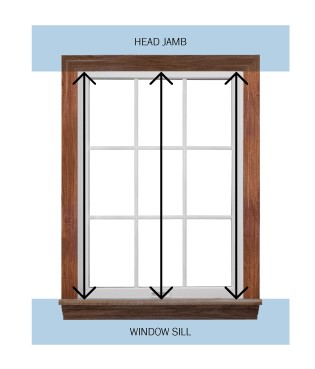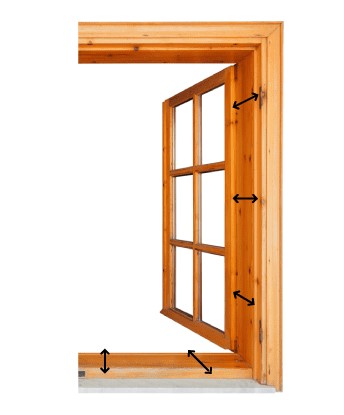Getting the right size windows for your home is crucial during a replacement project. Inaccurate measurements can lead to delays, additional costs, and poorly fitting windows that compromise energy efficiency and aesthetics. Replacing windows is a significant investment for any homeowner, and ensuring accurate measurements is crucial for a successful outcome.
This guide will walk you through the process of measuring windows for replacement in the UK, ensuring a smooth and successful installation.
Why Accurate Measurements Matter
Precise measurements are essential for several reasons:
- Perfect Fit: Replacement windows are custom-made to fit the exact opening in your wall. Incorrect measurements can result in windows that are too large or small, leading to gaps or tight squeezes. These issues can affect insulation, security, and overall functionality.
- Reduced Installation Time: Having accurate measurements allows the window supplier to pre-fabricate the windows to the correct size. This eliminates the need for on-site adjustments and minimizes disruption during installation.
- Cost-Effectiveness: Incorrect measurements can lead to additional costs. If windows are too small, you’ll need to pay for replacements. If they’re too large, modifications might be necessary, adding to the labour cost.
Understanding Window Measurements
Explanation of Different Parts of a Window
When it comes to measuring windows, it’s essential to understand the various components that contribute to its overall dimensions. These components include the frame, sash, and any additional features such as muntins or trim.
Importance of Measuring Width and Height Accurately
Measuring both the width and height of a window accurately is vital for ensuring a proper fit during replacement. Even slight discrepancies in measurements can lead to issues such as gaps or difficulty in installation.
Tools Required for Accurate Measurements
Before you begin measuring your windows, gather the necessary tools, including a tape measure, level, and possibly a step ladder for reaching higher windows. These tools will help you obtain precise measurements with ease.
Tools and Materials
Before you begin measuring, gather the following tools and materials:
- Tape Measure: A reliable tape measure with a clear metric scale is essential. A minimum length of 3 meters (10 feet) is recommended, especially for larger windows.
- Notepad and Pen/Pencil: You’ll need to record your measurements for reference.
- Level (Optional): While not strictly necessary, a level can help you check if the window opening is square.
Step-by-Step Guide to Measuring Windows
Measuring the Width
- Identifying the Inside Frame Width: Begin by locating the inside edges of the window frame. This is where you’ll take your width measurements from.
- Measuring Across the Width Accurately: Using a tape measure, measure the distance between the inside edges of the frame horizontally. Take measurements at multiple points along the width to account for any irregularities.

Image source: modernize
Measuring the Height
- Identifying the Inside Frame Height: Locate the inside edges of the window frame vertically to determine the height measurement.
- Measuring from Top to Bottom Accurately: With the tape measure, measure the distance between the top and bottom inside edges of the frame. Again, take measurements at multiple points for accuracy.

Image source: modernize
Additional Measurements
- Checking the Squareness of the Window: Use a level to ensure that the window frame is square. If it’s not, you may need to adjust your measurements accordingly.
- Measuring the Depth of the Window Frame: Measure the depth of the window frame from the inside edge to the outermost point. This measurement is crucial for selecting the right replacement window.

Image source: modernize
Tips and Tricks for Accurate Measurements
Double-Checking Measurements for Accuracy
After taking your initial measurements, double-check them to ensure accuracy. It’s better to spend a few extra minutes verifying measurements than to encounter issues during installation.
Dealing with Irregularly Shaped or Old Windows
If you have irregularly shaped or old windows, measuring may be more challenging. In such cases, take multiple measurements from different angles to capture the true dimensions accurately.
Considering Window Trim and Casing in Measurements
Don’t forget to account for any window trim or casing in your measurements. These elements can affect the overall dimensions of the window and may require adjustments when selecting a replacement.
Taking Multiple Measurements for Confirmation
To ensure the highest level of accuracy, take multiple measurements of each window and compare them. If there are discrepancies, re-measure until you achieve consistency.
Common Mistakes to Avoid
Misunderstanding the Terminology
It’s essential to understand the terminology associated with window measurements to avoid confusion. Familiarize yourself with terms such as frame width, sash height, and rough opening to communicate effectively with suppliers and installers.
Neglecting to Account for Window
Frame Dimensions The dimensions of the window frame, including its depth and thickness, play a significant role in replacement window selection. Failure to account for these dimensions can result in ill-fitting replacements.
Failing to Measure All Windows, Assuming
They Are Identical Even if your windows appear identical, it’s essential to measure each one individually. Variations in dimensions can occur due to factors such as settling or structural changes over time.
Ignoring the Importance of Accurate Measurements
Accurate measurements are the foundation of a successful window replacement project. Cutting corners or guessing measurements can lead to costly mistakes and delays.
Conclusion
Measuring windows for replacement in the UK requires attention to detail and precision. By following the step-by-step guide outlined in this article and avoiding common pitfalls, you can ensure that your replacement windows fit perfectly and enhance both the aesthetic appeal and energy efficiency of your home.
Remember, taking the time to measure accurately is the first step towards a successful window replacement project.
Frequently Asked Questions (FAQs)
When measuring a window for replacement, accuracy is crucial. Start by measuring the width and height of the window frame from inside to inside, ensuring you take measurements at three points: top, middle, and bottom for width, and left, center, and right for height. This helps account for any irregularities in the frame. Additionally, measuring diagonally from corner to corner can confirm if the frame is square. Always use the smallest measurements to ensure the replacement window fits properly. Taking precise measurements ensures that the new window will fit snugly and function correctly once installed.
DIY window fitting in the UK is possible with the right knowledge and tools. However, it’s essential to understand building regulations and safety standards to ensure compliance and avoid potential issues. While fitting your own windows can save money, it’s crucial to assess your skills and comfort level with the task. Simple replacements may be manageable for confident DIYers, but complex installations or those involving structural changes are best left to professionals. Before starting any DIY project, thoroughly research the process, gather the necessary tools and materials, and consider consulting with professionals if you encounter any uncertainties.
Replacement windows should fit precisely within the existing frame to ensure proper functionality and energy efficiency. When installing a replacement window, make sure it fits snugly within the frame, with no gaps between the window and the frame. Shims can be used to adjust for any unevenness in the frame, ensuring a level and secure fit. Proper sealing is also essential to prevent drafts and moisture infiltration. Seal the edges with caulk or weatherstripping to create a tight barrier against the elements. Taking care to ensure a proper fit during installation will result in a window that operates smoothly and enhances the comfort and energy efficiency of your home.
Calculating the size and specifications of uPVC windows involves several factors. Start by accurately measuring the dimensions of the window opening, considering both width and height. Next, determine the style and configuration of the window, such as single-hung, double-hung, or casement, based on your preferences and the design of your home. Consider any additional features or options, such as glazing choices, grid patterns, or decorative elements, that you want to incorporate into your windows. Finally, consult with a reputable supplier or utilize online calculators to estimate the cost and material requirements accurately. By carefully considering these factors, you can ensure that your uPVC windows meet your needs and complement the aesthetics of your home.
